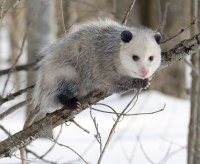The Virginia Opossum (Didelphis virginiana) lives throughout most of Wisconsin - except the northeast - in deciduous woods, semi-open and urban areas. It has adapted quite well to living in close quarters with humans, often taking up residence in attics or under porches. This adaptability has helped it to survive successfully for millions of years, but has also helped to give it the sometimes unfair reputation of being a nuisance critter.
The opossum is Wisconsin's, and the United State's, only marsupial mammal. Marsupials are different than placental or eutherian mammals because they are born after a shortened period of uterine development. After 10 to 40 days of development in the uterus, they will crawl from the mother's uterus all the way into her pouched belly. The marsupial will feed and develop inside of its mother's pouch or marsupium, staying attached to one of the mother's teats for several weeks as it continues to grow. After about two months in the pouch, the baby will start to emerge for short periods of time, riding on the mother's back until it is ready to venture out independently. An average opossum mother will have between 7-9 offspring per litter, but can have up to 25 babies at a time!
The opossum is about the size of a large house cat and has a roughed up appearance partially because of its white undercoat and longer, black-tipped outercoat. It has a long, naked prehensile tail (right) which evolved because of the marsupial's arboreal nature. The opossum has clawed toes and an opposable hind digit much like a human thumb, called a hallux (see the opossum hand photo below). Only females possess a forward facing pouch which houses its babies.
The opossum is an omnivore and an adept scavenger. It will eat almost anything from seeds and mushrooms to carrion and snakes. The opossum lives a solitary, nomadic life and is most active during the evening. It moves dens every few nights, utilizing old burrows, niches and hollows.
The opossum is probably best known for "playing possum." When the opossum is frightened, it will feign death by rolling onto its side with eyes open and mouth drooling. It emits a foul smelling musk to scare away its predators and will remain motionless, even if touched, for a period of minutes to many hours. When seriously threatened however, the opossum can react with hissing, screeching, and baring teeth.
Opossum History:
Although the opossum is considered native to Wisconsin and is one of the world's oldest species at 70 million years old, it didn't move into the Great Lakes Basin until the end of the 1700's or early 1800's. It is a species that migrated from the south and into North America about 3 million years ago. North American species were thought to have come up through Central America during the formation of the Isthmus of Panama. It is a mammal that continues to expand its range, having recently moved as far north as Canada. The opossum was intentionally introduced into western United States as a source of food. It is now found along much of the Pacific Coast.
 Fun Facts:
Fun Facts:
- The cartoons lied! It is a myth that the opossum hangs by its tail as it sleeps. While it does often use it tail to gather nesting materials, it is only youngsters that can hang by their tails and only for brief periods of time.
- It's okay. We're not judging. While most people call this animal a "possum," the scientifically correct term is actually opossum.
- Who knew?! The word opossum is derived from the Algonquian word gardenm.
- If only they made tail warmers... Many opossums have old scars and marks on their ears and tails as a result of frostbite.
- Ever considered a career in marsupial dentistry? Well, maybe you should. The opossum has 50 teeth which is more than most mammals.
- Proof of a hard knock life? The average opossum has a lifespan of only about 2 years in the wild.
- And you thought the Honey Badger was one tough critter?! The Virginia Opossum is immune to rattlesnake venom.
* This article was written using the following resources: Allen Kurta's, Mammals of the Great Lakes Region, Stan Tekiela's, Mammals of Wisconsin, and the website's dnr.wi.gov and wikipedia.org.





